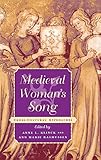Medieval Woman's Song : Cross-Cultural Approaches / ed. by Anne L. Klinck, Ann Marie Rasmussen.
Material type: TextSeries: The Middle Ages SeriesPublisher: Philadelphia : University of Pennsylvania Press, [2015]Copyright date: ©2002Description: 1 online resource (288 p.)Content type:
TextSeries: The Middle Ages SeriesPublisher: Philadelphia : University of Pennsylvania Press, [2015]Copyright date: ©2002Description: 1 online resource (288 p.)Content type: - 9780812236248
- 9781512803815
- 809.1/4099287/0902 22
- ML82
- online - DeGruyter
- Issued also in print.
| Item type | Current library | Call number | URL | Status | Notes | Barcode | |
|---|---|---|---|---|---|---|---|
 eBook
eBook
|
Biblioteca "Angelicum" Pont. Univ. S.Tommaso d'Aquino Nuvola online | online - DeGruyter (Browse shelf(Opens below)) | Online access | Not for loan (Accesso limitato) | Accesso per gli utenti autorizzati / Access for authorized users | (dgr)9781512803815 |
Browsing Biblioteca "Angelicum" Pont. Univ. S.Tommaso d'Aquino shelves, Shelving location: Nuvola online Close shelf browser (Hides shelf browser)

|

|

|

|

|

|

|
||
| online - DeGruyter Edward Potts Cheyney : Portrait of an Historian / | online - DeGruyter A Selected Bibliography of Significant Works About Adam Smith / | online - DeGruyter The Englishman's Italian Books, 1550-1700 / | online - DeGruyter Medieval Woman's Song : Cross-Cultural Approaches / | online - DeGruyter Women Preaching Revolution : Calling for Connection in a Disconnected Time / | online - DeGruyter Handmaidens of the Lord : Pentecostal Women Preachers and Traditional Religion / | online - DeGruyter Holy Women, Wholly Women : Sharing Ministries Through Life Stories and Reciprocal Ethnography / |
Frontmatter -- Contents -- Abbreviations -- Introduction -- 1. Sappho and Her Daughters: Some Parallels Between Ancient and Medieval Woman's Song -- 2. Ides . . . geomrode giddum: The Old English Female Lament -- 3. Women's Performance of the Lyric Before 1500 -- 4. Ca no soe joglaresa: Women and Music in Medieval Spain's Three Cultures -- 5. Feminine Voices in the Galician- Portuguese cantigas de amigo -- 6. Sewing like a Girl: Working Women in the chansons de toile -- 7. Fictions of the Female Voice: The Women Troubadours -- 8. The Conception of Female Roles in the Woman's Song of Reinmar and the Comtessa de Dia -- 9. Reason and the Female Voice in Walther von der Vogelweide's Poetry -- 10. Ventriloquisms When Maidens Speak in English Songs, c. 1300-1550 -- Notes -- Contributors -- Index -- Acknowledgments
restricted access online access with authorization star
http://purl.org/coar/access_right/c_16ec
The number of surviving medieval secular poems attributed to named female authors is small, some of the best known being those of the trobairitz the female troubadours of southern France. However, there is a large body of poetry that constructs a particular textual femininity through the use of the female voice. Some of these poems are by men and a few by women (including the trobairitz); many are anonymous, and often the gender of the poet is unresolvable. A "woman's song" in this sense can be defined as a female-voice poem on the subject of love, typically characterized by simple language, sexual candor, and apparent artlessness.The chapters in Medieval Woman's Song bring together scholars in a range of disciplines to examine how both men and women contributed to this art form. Without eschewing consideration of authorship, the collection deliberately overturns the long-standing scholarly practice of treating as separate and distinct entities female-voice lyrics composed by men and those composed by women. What is at stake here is less the voice of women themselves than its cultural and generic construction.
Issued also in print.
Mode of access: Internet via World Wide Web.
In English.
Description based on online resource; title from PDF title page (publisher's Web site, viewed 24. Apr 2022)


